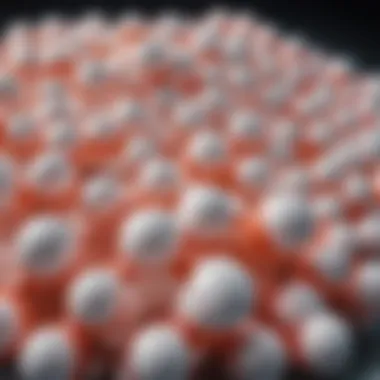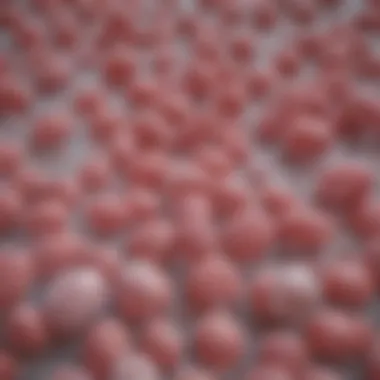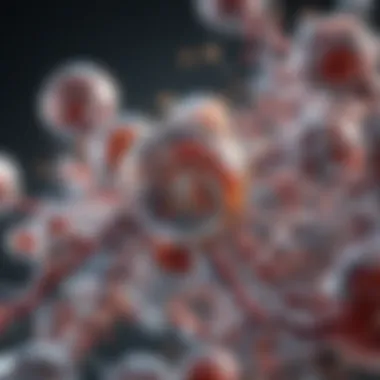Exploring Clavulanic Acid and Amoxicillin Synergy


Intro
The interplay between clavulanic acid and amoxicillin presents a compelling case in the discourse on antibiotic therapy. This article examines the dynamic relationship between these two compounds, their individual and synergistic mechanisms, as well as their relevance in clinical practice. Clavulanic acid, a beta-lactamase inhibitor, plays a crucial role in enhancing the efficacy of amoxicillin, a penicillin derivative. Understanding this synergy is vital for addressing contemporary challenges such as antibiotic resistance, which threatens the effectiveness of many existing therapies.
Research Overview
Summary of Key Findings
Research highlights several pivotal discoveries regarding the mechanisms at play between clavulanic acid and amoxicillin. Clavulanic acid protects amoxicillin from degradation by beta-lactamases, allowing for a broader spectrum of antibacterial activity. The combination not only enhances clinical outcomes but also contributes to reducing the occurrence of resistance. Studies have shown that this combination is especially effective against organisms like Haemophilus influenzae, Escherichia coli, and Staphylococcus aureus. Furthermore, the clinical applications of this combination extend beyond mere infection treatment; they also include its use in prophylaxis and in patients with compromised immune systems.
Relevance to Current Scientific Discussions
The synergistic relationship of these drugs is relevant in the discussions surrounding antibiotic stewardship and microbial resistance patterns. Conversations in the scientific community emphasize the need for judicious use of antibiotics, especially combinations like amoxicillin and clavulanic acid. Such discussions underscore the importance of optimizing treatment protocols to preserve the effectiveness of existing antibiotics. Current research trends focus not only on the mechanisms of synergy but also on emerging bacterial resistance. Finding ways to mitigate resistance is a pressing concern for healthcare professionals globally.
Methodology
Research Design and Approach
The studies investigating the relationship between clavulanic acid and amoxicillin often employ randomized controlled trials and observational studies. These designs aim to acquire robust data regarding the efficiency and safety of the drug combination in various patient populations. The trials typically assess clinical outcomes, microbiological response, and any adverse events associated with therapy.
Data Collection and Analysis Techniques
Data collection mostly involves recording patient demographics, treatment protocols, bacteriological results, and clinical outcomes. Advanced statistical methods are applied to analyze this data, aiming to establish a significant correlation between the combined therapy and improved patient outcomes. Meta-analyses are also conducted to synthesize data from multiple studies, providing a well-rounded view of the efficacy in diverse clinical scenarios.
The synergy of amoxicillin and clavulanic acid serves not only as an effective treatment but also as a focal point for discussions regarding antibiotic resistance, making its study crucial in modern medicine.
Prologue to Clavulanic Acid and Amoxicillin
The combination of clavulanic acid and amoxicillin represents a significant advancement in antibacterial therapy. Understanding how these two compounds work together is crucial for healthcare professionals. The unique properties of both agents provide a more effective treatment option, especially in the context of rising antibiotic resistance. Their synergy can enhance clinical outcomes in various infections, making them relevant in today's medical practices.
This section will explore the foundational aspects of each compound, setting the stage for a deeper investigation into their pharmacological properties and clinical applications.
Defining Clavulanic Acid
Clavulanic acid is a beta-lactamase inhibitor. It is structurally related to penicillin but does not have significant antibacterial activity on its own. Instead, its primary function is to inhibit the enzymes produced by certain bacteria that could otherwise deactivate beta-lactam antibiotics. By blocking these enzymes, clavulanic acid allows antibiotics like amoxicillin to remain effective against bacteria that are typically resistant. Its mechanism is essential in treating infections caused by resistant strains, enhancing the overall efficacy of the treatment regimen.
Defining Amoxicillin
Amoxicillin is a broad-spectrum antibiotic, a member of the penicillin class. It is commonly used to treat infections caused by several types of bacteria. These include but are not limited to respiratory tract infections, urinary tract infections, and skin infections. Amoxicillin works by interfering with bacterial cell wall synthesis, leading to cell death. However, many bacteria have developed resistance to amoxicillin over time. By combining it with clavulanic acid, clinicians can overcome some of these resistance mechanisms, thus preserving its effectiveness.
Combining clavulanic acid with amoxicillin represents a critical step in combating bacterial infections. This understanding lays the groundwork for exploring their pharmacological properties and real-world applications in the medical field.
Pharmacological Properties
Pharmacological properties are critical when discussing any therapeutic agents, particularly antibiotics like amoxicillin and clavulanic acid. Their distinct characteristics determine how they interact within the body, influencing both effectiveness against pathogens and the emergence of resistance. Understanding these properties is essential for optimizing their use in clinical settings.
Mechanism of Action of Amoxicillin


Amoxicillin is a bactericidal agent that operates by inhibiting the synthesis of bacterial cell walls. It targets the penicillin-binding proteins (PBPs), which are vital for cell wall integrity. When these proteins are inhibited, the bacteria cannot maintain their cell wall structure, leading to lysis and death of the bacterial cells.
The specificity of amoxicillin against Gram-positive and some Gram-negative bacteria makes it a widely used antibiotic. Some examples of the targeted bacteria include Streptococcus pneumoniae and Escherichia coli. This selective action allows for targeted treatments while minimizing harm to beneficial flora in the human body.
Mechanism of Action of Clavulanic Acid
Clavulanic acid serves as a potent beta-lactamase inhibitor. It protects amoxicillin from degradation by certain enzymes that bacteria produce to resist beta-lactam antibiotics. In doing so, it extends the spectrum of amoxicillin's activity. The action is particularly effective against beta-lactamase producing organisms, which are increasingly common in clinical settings.
Understanding how clavulanic acid neutralizes these enzymes is key to appreciating its role in combination therapies. By preventing the breakdown of amoxicillin, clavulanic acid allows more effective treatment of infections that would otherwise be resistant to standard therapies.
Synergistic Effects of the Combination
The combination of clavulanic acid and amoxicillin is beneficial due to their complementary mechanisms. While amoxicillin disrupts bacterial cell wall synthesis, clavulanic acid inhibits the enzymes that some bacteria use to defend against beta-lactam antibiotics. This dual action leads to a synergistic effect that enhances the overall efficacy of the treatment.
The advantages of this synergy include:
- Broader Spectrum of Activity: The combination can tackle a wider range of bacteria.
- Reduced Risk of Resistance: Using both agents together lowers the likelihood that bacteria will develop resistance to treatment.
- Shortening Treatment Duration: More effective treatment options can lead to quicker recoveries and reduced need for extensive therapy.
"The synergistic relationship between clavulanic acid and amoxicillin underscores the importance of combination therapy in modern medicine."
This combination has become a staple in many guidelines, demonstrating its significance in combating bacterial infections. Furthermore, it highlights the ongoing need for continued research and understanding of how to effectively manage antibiotic resistance.
Clinical Applications
The clinical applications of clavulanic acid and amoxicillin represent a vital area in antibiotic therapy. When used in combination, these two compounds provide a broader spectrum of activity against bacteria, particularly beta-lactamase-producing strains. This is important given the rising rates of antibiotic resistance observed in recent years. Understanding when and how to use this combination effectively can maximize patient outcomes and minimize risks associated with antibiotic misuse.
The use of this combination is significant in several diseases, especially infections that are caused by resistant organisms. In cases such as respiratory tract infections, skin and soft tissue infections, and urinary tract infections, clinicians must consider the current resistance patterns and the specific bacterial pathogens involved. Therefore, the decision to use clavulanic acid and amoxicillin together is often driven by the bacterial profile and patient factors, such as allergy history and potential drug interactions.
Indications for Combined Use
Clavulanic acid serves an essential role as a beta-lactamase inhibitor, rendering it a powerful partner to amoxicillin, a broad-spectrum antibiotic. The indications for combined use are numerous:
- Infectious Diseases: It is especially effective against pathogens like Escherichia coli and Haemophilus influenzae, which frequently produce beta-lactamase enzymes.
- Empirical Therapy: The combination is often employed in empirical treatment when infections are suspected but not yet confirmed through culture.
- Resistance Patterns: In regions with high levels of penicillin-resistant Streptococcus pneumoniae, this combination allows clinicians to cover a wider array of potential pathogens.
In practical terms, this combined therapy is valuable in treating both community-acquired and hospital-acquired infections. For instance, it is extensively used in outpatient settings due to its effectiveness and safety profile, making it a first-line treatment option in various circumstances.
Comparison with Other Antibiotic Combinations
When comparing the clavulanic acid-amoxicillin combination with other antibiotic pairings, several factors emerge: efficacy, resistance mitigation, and adverse effects. Here are some aspects to consider:
- Amoxicillin and Clavulanic Acid vs. Ceftazidime: While ceftazidime may be effective in certain settings, it does not offer the same spectrum coverage against beta-lactamase-producing bacteria. The combination remains more effective in many clinical scenarios.
- Clindamycin and Gentamicin: This combination is often used for specific soft tissue infections. However, when broad-spectrum coverage is required, amoxicillin and clavulanic acid provide a more comprehensive solution.
- Piperacillin-Tazobactam: Another popular combination, piperacillin-tazobactam, can also combat resistance but tends to be reserved for more severe cases due to its cost and potential toxicity.
In summary, while other antibiotic combinations exist, the synergistic relationship between clavulanic acid and amoxicillin often renders it the preferred choice in various clinical situations. This choice fosters better management of infections, highlighting the importance of understanding the specific contexts in which these antibiotics shine.
Antibiotic Resistance and Challenges
Antibiotic resistance poses a significant challenge in modern medicine. It threatens to undermine decades of progress in treating bacterial infections effectively. This issue is especially relevant to the discussion about clavulanic acid and amoxicillin, as understanding their role in combating resistance is crucial for guiding their appropriate use in clinical settings.


Typically, resistance arises when bacteria evolve mechanisms to withstand the effects of antibiotics. This phenomenon has been accelerated by various factors, including over-prescription of antibiotics, incomplete courses of treatment, and agricultural use in livestock. As a result, infections that were once easily treatable now require more aggressive and potentially toxic alternatives.
Overview of Antibiotic Resistance
Antibiotic resistance is characterized by the ability of bacteria to resist the effects of medications that once eliminated them. Resistance mechanisms include enzyme production, alterations in drug targets, and changes in permeability barriers. For example, certain bacteria produce beta-lactamases which destroy the beta-lactam structure of many penicillins, including amoxicillin.
The Centers for Disease Control and Prevention (CDC) emphasizes the gravity of antibiotic resistance, highlighting that at least 2.8 million infections are caused by resistant organisms each year in the United States alone. This statistic sheds light on an urgent need for effective antibiotic stewardship, which includes responsible prescribing practices and the development of new therapeutic strategies.
Role of Clavulanic Acid in Combating Resistance
Clavulanic acid plays a vital role in addressing the challenges posed by antibiotic resistance. It is a beta-lactamase inhibitor specifically designed to counteract enzymes produced by resistant bacteria. By pairing clavulanic acid with amoxicillin, the combination can preserve the efficacy of amoxicillin against otherwise resistant strains. This affinity to neutralize beta-lactamases broadens the spectrum of amoxicillin, allowing for successful treatment where monotherapy could fail.
Studies have demonstrated that this combination can effectively treat infections caused by beta-lactamase-producing organisms, enhancing the overall effectiveness of amoxicillin. Furthermore, utilizing clavulanic acid minimizes the need for more potent and toxic alternative antibiotics, which can have detrimental side effects on patients’ health.
Impact on Clinical Practice
The implications of antibiotic resistance influence daily clinical practices profoundly. Antimicrobial stewardship programs advocate for the combination of clavulanic acid and amoxicillin as a frontline treatment for various infections, such as skin and soft tissue infections, urinary tract infections, and respiratory tract infections. These guidelines help ensure that healthcare providers employ effective treatments while also mitigating harm caused by inappropriate antibiotic use.
The combination therapy not only enhances clinical outcomes but also reduces the risk of escalating to last-line antibiotics. This practice is essential, especially for conditions that have become complicated due to resistance trends. Thus, clavulanic acid-amoxicillin dual therapy becomes a strategic approach that balances effective treatment with resistance mitigation.
"Addressing antibiotic resistance requires a multifaceted approach, combining effective treatments and prudent use of existing antibiotics to preserve their efficacy in the long term."
Ultimately, the synergy between clavulanic acid and amoxicillin showcases an essential advancement in managing antibiotic resistance. This strategy addresses immediate clinical needs while paving the way for more sustainable practices in antibiotic therapy.
Pharmacokinetics and Pharmacodynamics
Pharmacokinetics and pharmacodynamics are crucial elements in understanding how drugs like clavulanic acid and amoxicillin operate within the body. These concepts address how the body absorbs, distributes, metabolizes, and excretes drugs, and how these drugs exert their effects on the body. In the context of clavulanic acid and amoxicillin, recognizing these factors helps clinicians optimize treatment protocols, ensuring efficacy while minimizing adverse outcomes. By delving into these areas, one can appreciate the complexities of antibiotic therapy and the strategies needed to tackle bacterial infections.
Absorption and Distribution
Absorption refers to the process by which a drug enters the bloodstream. In the case of amoxicillin, it is generally well-absorbed after oral administration. Peak plasma concentrations occur approximately one to two hours after taking the medication. Clavulanic acid follows a similar absorption profile but has distinct pharmacokinetic properties that enhance the efficacy of amoxicillin.
When discussing distribution, it is essential to understand how these compounds travel through the body. Both drugs can penetrate various tissues, with amoxicillin reaching therapeutic levels in most body compartments, including the lungs, sinuses, and skin. Clavulanic acid also distributes widely, but it may exhibit a unique distribution pattern influenced by factors like protein binding and tissue characteristics.
Metabolism and Elimination
The metabolism of clavulanic acid and amoxicillin is an important consideration in their effective use. Amoxicillin is primarily excreted without substantial metabolism in the liver. About 60 to 70% of an oral dose is eliminated through the kidneys in its active form.
In contrast, clavulanic acid undergoes some hepatic metabolism. Its metabolic process results in various compounds, with a significant portion also being eliminated through the kidneys. Understanding these metabolic pathways helps to anticipate drug interactions.
Elimination kinetics are pivotal in determining dosing regimens for patients. For patients with compromised renal function, alternatives must be considered to avoid toxicity from drug accumulation. Monitoring renal function becomes essential to provide tailored therapy for optimal outcomes.
Both drugs have a relatively short half-life, prompting frequent dosing in many cases. This characteristic necessitates diligent scheduling to ensure therapeutic levels are maintained, especially in treating persistent infections. Understanding the pharmacokinetics and pharmacodynamics of amoxicillin and clavulanic acid thus helps inform practical guidelines for antibiotic therapy.
Current Research Trends
Current research trends related to clavulanic acid and amoxicillin focus on several key areas that highlight their significance in modern antibiotic therapy. The exploration of efficacy, resistance mechanisms, and the continual development of innovative applications is essential. For researchers, understanding these dynamics not only underpins the enduring relevance of these agents but also reveals future prospects for tackling antibiotic resistance.


Research efforts have intensified, aiming to clarify the mechanisms of synergy between clavulanic acid and amoxicillin. This synergy enhances bacterial killing compared to amoxicillin alone. These studies are important as they inform treatment protocols and help refine antibiotic use in clinical settings.
Studies on Efficacy
Research on the efficacy of clavulanic acid and amoxicillin often employs in vitro and in vivo testing. These studies measure the antimicrobial activity against various pathogens, particularly those exhibiting resistance. Recent studies show that the combination can significantly lower the Minimum Inhibitory Concentration (MIC) against resistant organisms compared to standalone treatments.
- Clinical Trials - Ongoing clinical trials seek to understand the effectiveness of different dosages and combinations, which can further optimize therapy.
- Target Pathogens - Research increasingly targets multidrug-resistant organisms. Efficacy studies highlight how the combination can effectively combat bacteria such as Methicillin-resistant Staphylococcus aureus (MRSA) and Enterobacteriaceae.
- Laboratory Findings - Laboratory studies have also confirmed that the enhanced effect of the combination is not just limited to bacterial killing, but also includes the prevention of resistance development in target pathogens.
Investigating New Applications
The investigation of new applications for clavulanic acid and amoxicillin is another critical research area. Studies are exploring the combination's potential beyond traditional uses. There is a growing interest in utilizing this pairing in various fields such as outpatient therapies and targeted treatments for infections caused by specific bacteria.
- Combination Therapies: Researchers are assessing the role of clavulanic acid and amoxicillin in combination with other antibiotics, potentially creating synergistic effects with new drugs.
- Treatment of Chronic Infections: Investigations are underway about the efficacy of this combination in chronic infections, such as those seen in cystic fibrosis patients, where traditional treatments may fail.
- Enhanced Formulations: There is also research into new formulations or delivery methods that may enhance the pharmacokinetics and delivery of the drugs. Targeted delivery systems could improve bioavailability and therapeutic outcomes.
"The combination of clavulanic acid and amoxicillin not only combats infection effectively but also potentially reduces the risk of developing antibiotic resistance, an increasing concern in today's medical landscape."
These research trends underscore the dynamic nature of antibiotic therapy and the necessity of continuous study. They highlight the need to stay abreast of novel developments that may influence treatment efficacy and a larger understanding of antibiotic resistance mechanisms.
Future Directions in Antibiotic Therapy
Antibiotic therapy is evolving rapidly in response to the growing threat of resistant microorganisms. The future directions in this area hold significant implications for clinical practice, patient outcomes, and public health. Understanding the trajectory of antibiotic development and application is essential, especially in the context of clavulanic acid and amoxicillin. These two compounds illustrate vital advancements in synergy, providing a foundation for new approaches to combat bacterial infections.
Emerging Treatments
The quest for novel treatments is paramount. Several strategies emerge to augment traditional therapies. Combination therapies like the one between clavulanic acid and amoxicillin remain at the forefront. This approach enhances efficacy and broadens the spectrum of action against resistant bacteria. Some other promising directions include:
- Beta-lactam/β-lactamase inhibitor combinations: Innovations continue in developing new inhibitors that can synergistically work with existing antibiotics.
- Phage therapy: Incorporating bacteriophages could offer a targeted approach against resistant strains. This method is particularly relevant as it may reduce collateral damage to healthy flora.
- Vaccination strategies: Immunization against specific pathogens could significantly reduce the need for extensive antibiotic use, ultimately lowering resistance development.
While the emergence of these treatments shows promise, they also require rigorous evaluation to ensure safety and efficacy.
The Role of Research in Development
Research is a cornerstone in adapting antibiotic strategies. Ongoing studies focus on several key aspects:
- Mechanistic understanding: Unraveling the mode of action of clavulanic acid and new combinations helps identify potential synergies.
- Clinical trials: Practical testing of emerging therapies ensures that the theoretical efficacy translates to real-world clinical benefits.
- Resistance patterns: Monitoring trends in bacterial resistance informs adjustments in therapy protocols and aids in predicting future challenges.
Continuous funding and support for antibiotic research are essential. Collaboration among academic institutions, healthcare professionals, and pharmaceutical companies can foster innovations that are urgently needed.
As we navigate the complexity of antibiotic therapy, it is evident that future directions are critical in shaping effective strategies against drug-resistant infections.
The End
The discussion surrounding clavulanic acid and amoxicillin highlights their significane in contemporary antibiotic therapy. This combination is not merely a solution for treating infections; it embodies a strategic response to the growing threats posed by antibiotic resistance. The effective use of these compounds can lead to improved patient outcomes, making it essential for healthcare providers to understand their underlying mechanisms and clinical applications.
Summary of Key Points
- Synergistic Relationship: Clavulanic acid enhances the efficacy of amoxicillin by inhibiting beta-lactamase enzymes, which are responsible for antibiotic resistance.
- Clinical Relevance: The combined use of these antibiotics has proven effective against a wide range of bacterial pathogens, particularly those producing beta-lactamases.
- Pharmacokinetics and Pharmacodynamics: Understanding how these drugs are absorbed, distributed, metabolized, and eliminated is critical for optimizing therapeutic outcomes.
- Current Research and Future Directions: Ongoing studies seek to expand the applications of this combination and address the challenges posed by evolving resistance mechanisms.
Final Thoughts on Clavulanic Acid and Amoxicillin
The relationship between clavulanic acid and amoxicillin reveals much about the intricate strategies necessary for effective antibiotic therapy. In light of the ever-increasing resistance among pathogens, the insights gained from research into this duo are invaluable.
Healthcare professionals are tasked with the responsibility of not only utilizing these antibiotics effectively but also of educating patients about their role in combating infections. Both patients and practitioners must prioritize the judicious use of antibiotics to preserve their effectiveness. The future of antibiotic therapy will rely heavily on understanding such combinations and how they can be optimized to meet clinical challenges.
The pursuit of knowledge in this area remains essential to enhance the efficacy of antibiotic therapy and address the challenges of resistance.



